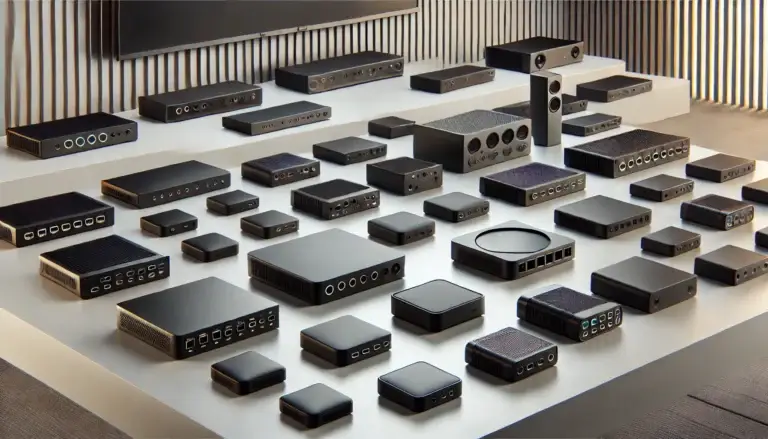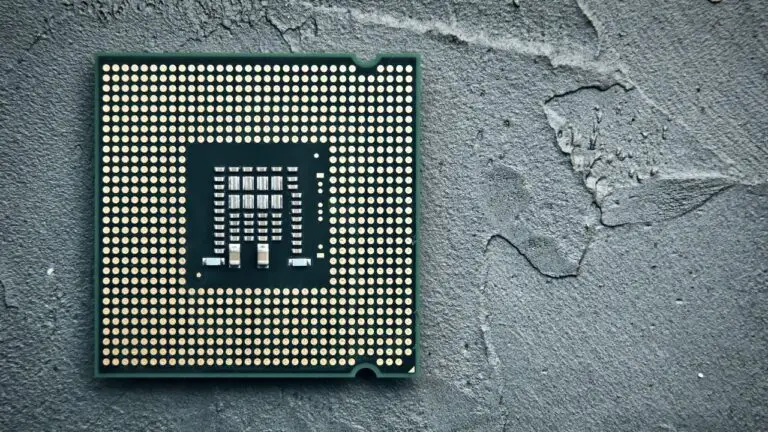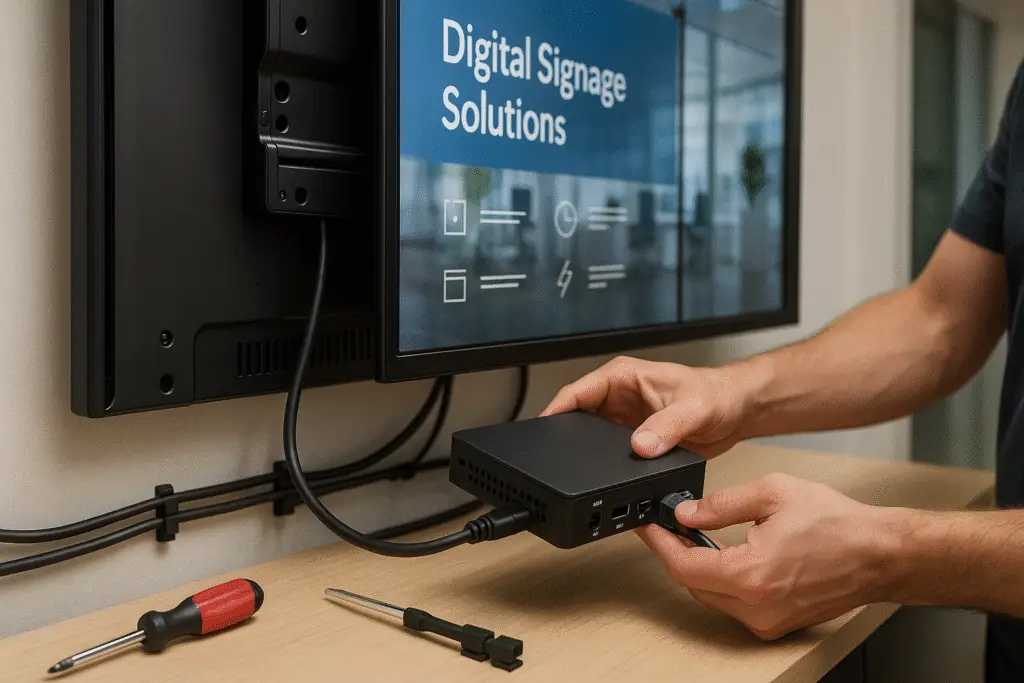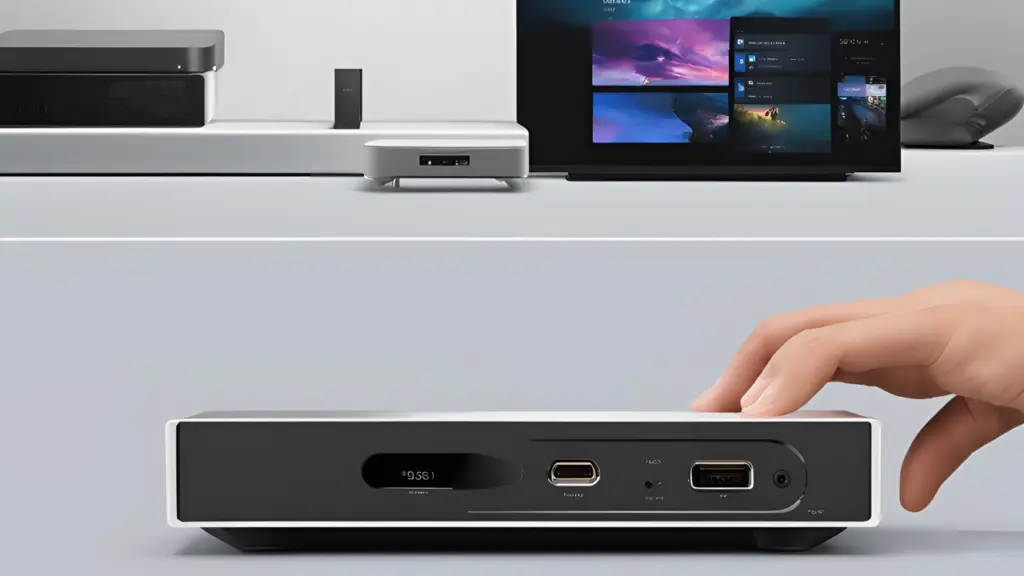Facing a digital signage rollout? You’ll soon hit this big question: Should you use SOC displays (System-on-Chip displays) or external media players?
This isn’t just about tech specs. Your choice affects your costs, how easy your network is to manage, and how long your system will stay current. Let’s skip the jargon and focus on what actually matters for your business.
What’s a Digital Signage Media Player?
Think of a digital signage player as the brain behind your screens. It’s what processes your content, runs your schedule, and talks to your content management system.
External media players are separate boxes that connect to your screens with an HDMI cable. They range from basic units that just loop videos to powerful machines that can handle interactive experiences and complex data.
These players usually run on one of these systems:
- Android: Affordable and works with most software
- Windows: Good for complex business applications
- Linux: Secure and can be customized for specific needs
- Chrome OS: Easy to manage remotely, uses less power
- Proprietary OS: Built by the manufacturer for their hardware only

What Is a System-on-Chip (SoC) Display?
System-on-Chip displays have the media player built right into the screen. No extra boxes or cables needed, just one complete unit.
Most system on chip displays run on the manufacturer’s own system. Samsung uses Tizen, LG uses webOS, and others use versions of Android. Think of them like commercial-grade smart TVs designed specifically for digital signage.
The big advantage? Simplicity. SoC displays are easier to install, have fewer cables, and generally look cleaner once mounted.
The Technical Breakdown: How SoC Displays and External Players Differ
When you dig into the technical details, SoC displays and external media players handle performance very differently. These differences can make or break your digital signage setup, especially when you’re dealing with demanding content or tight budgets. Here’s what you need to know about how each option performs in real-world situations.
Performance
External Media Players:
- Come in different power levels based on what you need
- Can be upgraded when you need more processing power
- Handle demanding content like interactive apps and video walls
- Often have better graphics capabilities
SoC Displays:
- Have fixed power that can’t be upgraded
- Work well for basic content (videos, images, web feeds)
- May struggle with processor-heavy applications
- Performance varies widely between brands and models
Installation and Setup
External Media Players:
- Require more installation time
- Need extra cables and mounting solutions
- Create more potential failure points
- Allow flexible placement options
SoC Player:
- Install much faster
- No extra cables or mounting hardware
- Cleaner, more streamlined appearance
- Fewer things that can break or fail
Cost Considerations
Initial Investment:
- System on chip displays cost more upfront than regular commercial screens
- External players add hardware and installation expenses
- Combined cost of display + player often exceeds SoC display price
Long-term Costs:
- System-on-chip screens use less power (one device instead of two)
- External players can be replaced without buying new screens
- SoC requires full display replacement when technology becomes outdated

Content Matters: Choosing Based on What You'll Show
Performance is where the biggest differences between SoC displays and external media players become obvious. Understanding these performance gaps will help you choose the right solution for your content needs and avoid frustrating bottlenecks down the road. Let’s break down what each option can actually handle.
SoC Displays Work Well For:
- Digital menu boards with regular updates
- Information displays and directories
- Simple slideshows and promotional videos
- Social media feeds and news updates
- Basic retail product showcases
External Players Are Better For:
- Touchscreen kiosks and interactive displays
- Video walls spanning multiple screens
- Complex layouts with multiple content zones
- Real-time data integrations (inventory, appointments)
- Advanced analytics and audience measurement
Top Manufacturers in 2025
Leading System On Chip Display Brands:
Samsung (Tizen):
- Reliable performance for standard applications
- Works well with major content management systems
- Popular in retail and corporate settings
- Sizes from 32″ to 98″
LG (webOS):
- Great display quality with stable webOS platform
- Strong in hospitality and retail
- Regular security updates
- Good warranty coverage
Sony (Android):
- High-quality screens with Android-based system
- Excellent video processing
- Popular in corporate and education
- Works with many Android apps
Philips (Android):
- Flexible Android-based system
- Energy-efficient models
- Popular in healthcare and education
- Good third-party integration
Top External Media Player Brands:
- Built specifically for digital signage
- Extremely reliable with low failure rates
- Strong security and remote management
- Great for large enterprise deployments
- Powerful Windows or Linux compatibility
- Highly customizable with various hardware options
- Can drive multiple displays from one unit
- Excellent for demanding applications
- Built for 24/7 commercial use
- Chrome OS or Windows options
- Fanless designs for better reliability
- Good for retail analytics integration
- External player that works with non-Samsung displays
- Consistent experience with Samsung’s ecosystem
- Good for mixed-display environments
- Centralized management option.
Book a free consultation today
Making the Right Choice for Your Needs
Not sure which way to go? Consider these key factors:
Choose System on a Chip Displays When:
- You need to keep costs down
- Space is limited or aesthetics are important
- Your content is mostly simple and scheduled
- You need fast deployment across many locations
- You have limited IT support resources
Choose External Media Players When:
- Your content includes interactive elements
- You expect your needs to grow or change
- You need custom applications or software
- You want to upgrade hardware without replacing screens
- You’re using multiple screen types or brands
Practical Considerations: Day-to-Day Management
Think about how your choice affects ongoing operations:
SoC Display Management:
- Updates can usually be done remotely
- Hardware issues require replacing the entire display
- Troubleshooting options are more limited
- Security updates depend on manufacturer schedules
External Media Player Management:
- Players can be swapped without removing displays
- More detailed system monitoring available
- Security updates tend to be more frequent
- More robust remote management options

Bottom Line: What’s Right for You?
Here’s what it comes down to:
If you need power, customization, and flexibility for the future, external media players are your best bet. They offer more processing capability, easier upgrades, and better adaptability as your needs change.
If you want simplicity, clean installation, and fast deployment, SoC displays deliver excellent value. They reduce complexity, have fewer failure points, and provide an all-in-one solution for many common signage needs.
Base your decision on:
- What kind of content you’ll show
- What IT resources you have available
- How your needs might grow
- Physical space constraints
- Budget (both initial and long-term)
Many successful networks actually use both SoC for simpler needs and external players for more demanding locations.
Need personalized advice for your signage project? Let’s talk about your specific needs.
Learn more in my full Digital Signage Hardware insights archive.
FAQ
What’s the difference between a System on Chip (SoC) display and an external media player?
An SoC player has the media player built directly into the screen. No extra box or wires. An external media player is a separate device that plugs into the display, like a BrightSign, Chromebox, or Intel NUC. Both do the same job, but SoC is sleeker while external players give you more power and flexibility.
Is an external media player better for digital signage?
It depends on your needs. External players are more powerful and easier to upgrade, so they’re great for complex content or custom apps. But they cost more and require more setup. If you’re just pushing simple content to a few screens, SoC might be all you need.
Are system on chip displays reliable for long-term digital signage use?
Yes, for many use cases, SoC displays are rock solid. Brands like Samsung and LG have invested heavily in them. But if your content is heavy, or you want to future-proof with advanced features like programmatic ads or analytics, an external player gives you more headroom.





